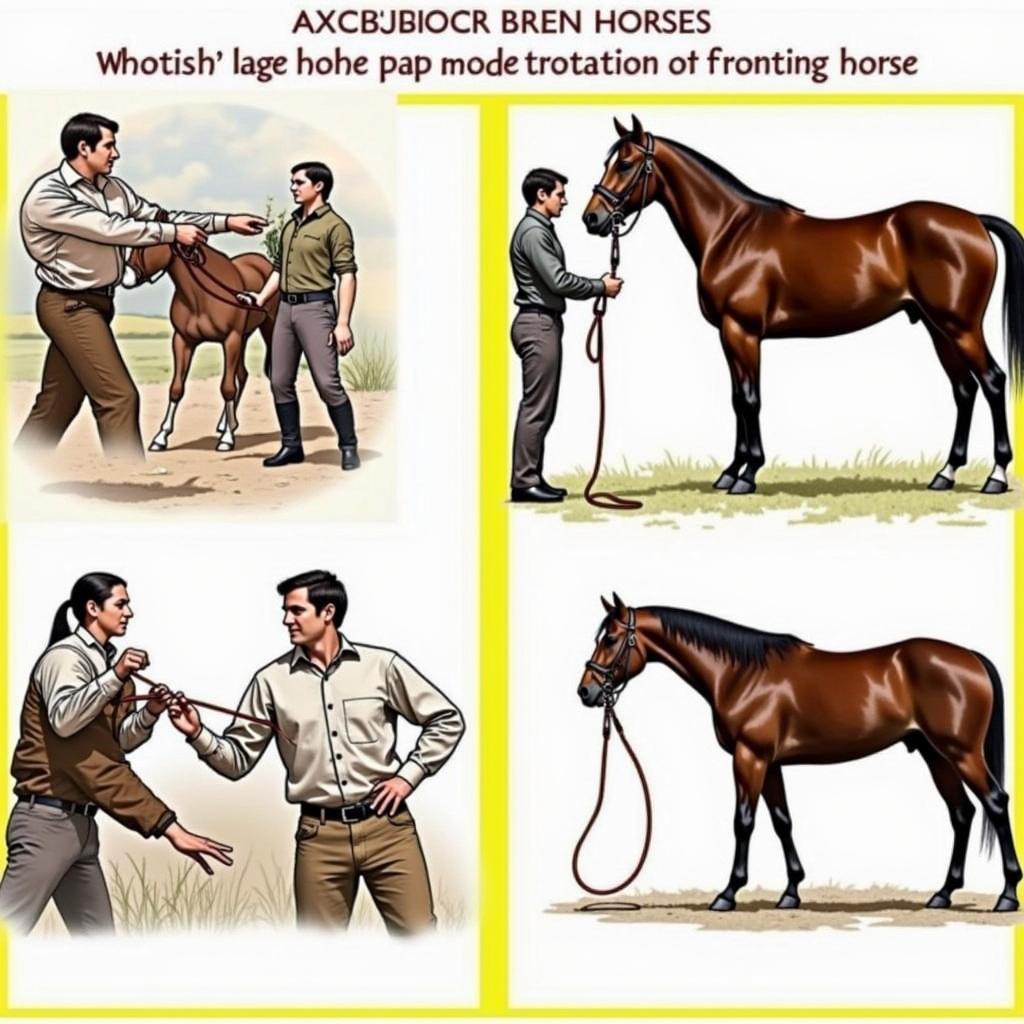Longeing a horse, also spelled lungeing, is a valuable training and exercise technique that every horse owner should understand. It involves working a horse on a circle at the end of a long line, called a lunge line, allowing for controlled movement and training. This guide will delve into the intricacies of longeing a horse, covering everything from its benefits and necessary equipment to step-by-step instructions and safety precautions.
Benefits of Longeing a Horse
Longeing offers a myriad of benefits for both horse and handler. It’s an excellent way to:
- Exercise Your Horse: Longeing provides a controlled environment for your horse to stretch their legs, build muscle, and improve cardiovascular health, particularly when turnout is limited.
- Train Young Horses: For young or green horses, longeing introduces basic voice commands and aids, preparing them for ridden work.
- Improve Communication and Trust: Longeing strengthens the bond between horse and handler by establishing clear communication and expectations.
- Assess Lameness: Observing a horse on the lunge can help identify subtle signs of lameness or stiffness that might not be apparent under saddle.
- Warm Up or Cool Down: Before or after ridden work, longeing can be used as an effective way to warm up muscles or cool down gradually.
Equipment Needed for Longeing
Before you begin longeing, gather the following equipment:
- Longe Line: A sturdy, long line, typically 25-30 feet long, specifically designed for longeing.
- Longe Whip: Used as an extension of your arm to encourage forward movement and maintain rhythm, not for hitting the horse.
- Longe Cavesson or Bridle: A longe cavesson is ideal as it provides a secure point of attachment for the lunge line without interfering with the horse’s mouth. Alternatively, a well-fitted bridle can be used with caution.
- Protective Boots: Consider using protective boots or bandages on your horse’s legs, especially if you’re working on hard ground or introducing new exercises.
- Gloves (Optional): Wearing gloves can provide a better grip on the lunge line and protect your hands from rope burn.
Step-by-Step Guide to Longeing a Horse
- Prepare Your Horse: Ensure your horse is properly groomed and outfitted with the necessary equipment.
- Choose a Safe Area: Select a level, well-fenced area free from obstacles. A round pen is ideal, but a corner of an arena can also work.
- Establish Your Position: Stand in the center of the circle, holding the lunge line in your dominant hand and the whip in the other.
- Ask for Forward Movement: Use your body language and voice commands to encourage your horse to walk forward onto the circle.
- Maintain Rhythm and Direction: Use the lunge whip and your voice to maintain a consistent rhythm and prevent the horse from cutting in or drifting out.
- Change Gaits Gradually: Once your horse is comfortable at a walk, you can ask for a trot and eventually canter, always transitioning smoothly between gaits.
- Incorporate Transitions: Include transitions within and between gaits to improve the horse’s responsiveness and balance.
- End the Session Positively: Gradually slow the horse down to a walk and allow them to cool down before ending the session on a good note.
Safety Tips for Longeing
- Never Wrap the Lunge Line Around Your Hand: This can result in serious injury if the horse spooks or pulls back.
- Be Aware of Your Surroundings: Keep an eye out for potential hazards in the environment, such as holes, uneven ground, or other animals.
- Use Appropriate Equipment: Ensure your equipment is in good condition and properly adjusted.
- Start Slowly and Gradually Increase Intensity: Don’t overdo it, especially with young or unfit horses.
Common Longeing Mistakes to Avoid
 Common Longeing Mistakes
Common Longeing Mistakes
- Pulling on the Lunge Line: This creates tension and restricts the horse’s movement. Use clear aids and encourage relaxation.
- Standing Too Close or Too Far: Maintain an appropriate distance to allow the horse to move freely without feeling crowded or ignored.
- Not Using the Whip Effectively: The whip is an extension of your arm, not a tool for punishment. Use it to encourage forward movement and maintain rhythm.
- Longeing for Too Long: Sessions should be kept short and focused, especially for young or unfit horses.
Longeing: A Foundation for Success
Mastering the art of longeing takes time, patience, and practice. It’s a versatile technique that can benefit horses of all ages and disciplines. By following the guidelines outlined in this comprehensive guide, you can longe your horse safely and effectively, maximizing their physical and mental well-being while strengthening the bond you share.
FAQs About Longeing a Horse
Q: How often should I longe my horse?
A: The frequency of longeing depends on the horse’s age, fitness level, and training goals. Two to three times per week can be beneficial, but always listen to your horse and consult with a veterinarian or equine professional for personalized advice.
Q: Can I use side reins while longeing?
A: Side reins can be used, but they should be introduced gradually and adjusted correctly. Improper use can cause tension and discomfort. Seek guidance from an experienced trainer to incorporate side reins safely and effectively.
Q: What are some signs that my horse is uncomfortable or stressed while longeing?
A: Look for signs such as tail swishing, pinning ears, head tossing, or resistance to move forward. If you notice these signs, stop the session and assess the situation. It might be necessary to adjust your technique, equipment, or consult a professional.
Looking for High-Quality Horse Halters?
We have a variety of horse halters available! Best horse halters.
For all your horse care needs, Justus Horses USA is here to help. Contact our 24/7 customer support line at 0772127271, email us at [email protected], or visit us at QGM2+WX2, Vị Trung, Vị Thuỷ, Hậu Giang, Việt Nam. We’re dedicated to providing you with the information and resources you need to care for your equine companion.